Seven things to keep in mind before committing to new garden furniture – according to the experts
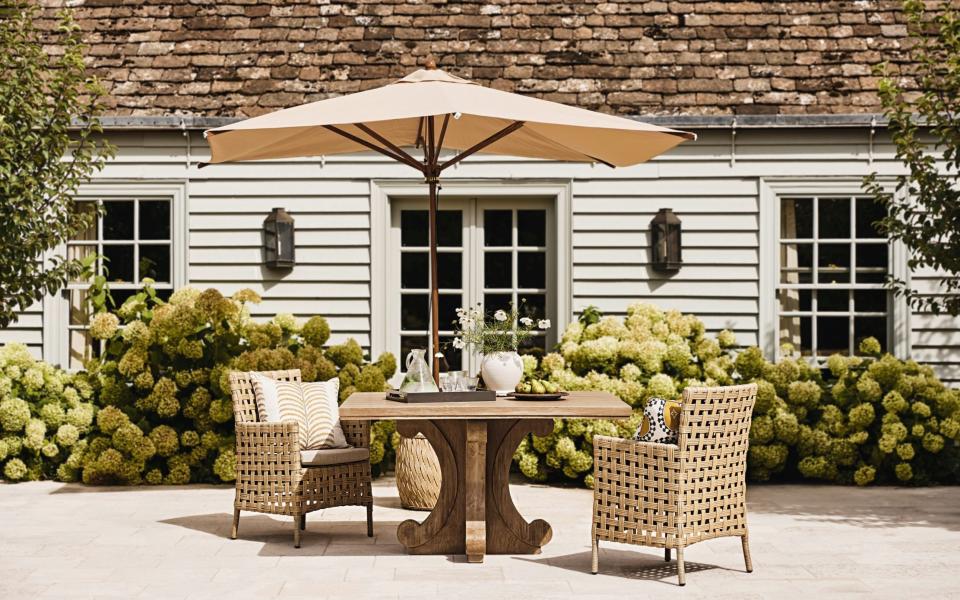
With spring finally on the horizon, it’s time to think about sprucing up your garden. And if you’re lucky enough to have an outside space, be it a large garden or a small terrace, the right outdoor furniture can increase its appeal exponentially.
“No matter how beautifully a garden is designed and planted, depressing furniture will affect the whole vibe, so it pays to make an effort to get it right,” says Emma Lyne, founder of garden design and soft landscaping company The London Gardener. “On the other hand, if a less well-planned garden is dressed with lovely pieces, they will most definitely improve the atmosphere.”
Peak pandemic, high demand made garden furniture as tricky to source as loo paper in early lockdown, but even though those days are thankfully in the past, it’s a good idea to think about potential new purchases now. “It’s worth noting that stocks run out fast from April onwards,” adds Lyne, “so order items soon to guarantee arrival for summer.”
Are you sitting comfortably?
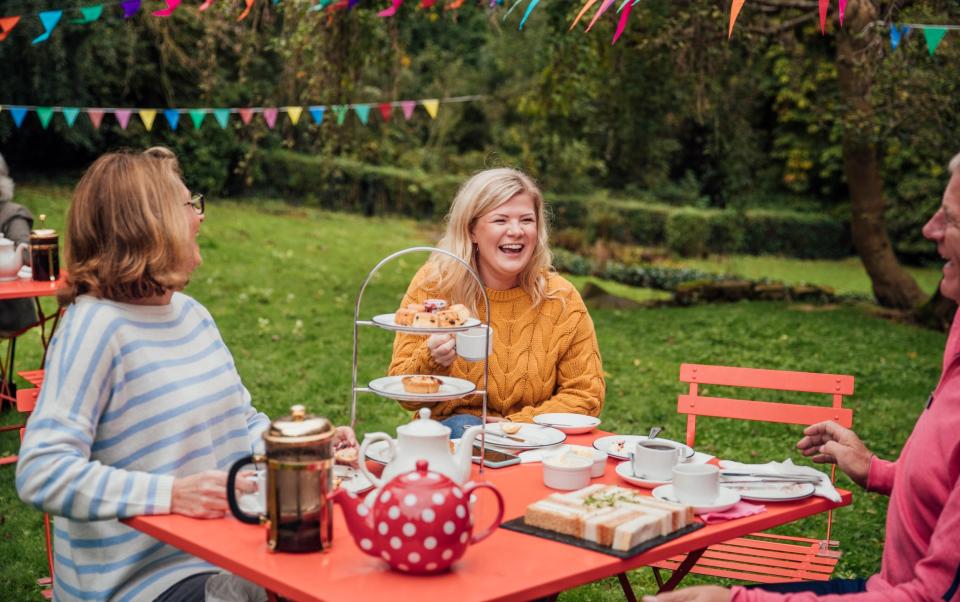
There are myriad materials, styles and configurations of furniture to choose from, so the first thing to consider is the way you use your garden. “Is upright dining or lounging more important to you?” says Chris Harrington, director at garden design-and-build practice Harrington Porter. “From a practical point of view, find a balance between what you need for parties and your regular day-to-day. You might occasionally host 10 people, but more often than not it’s going to be three or four, so your furniture shouldn’t be too dominant.”
Particularly in urban environments, L-shaped sofa-style seating makes good use of a corner plot, and if your garden is on the smaller side, opt for an extendable table with stacking or folding garden chairs. “You can always bring chairs out from your kitchen to boost numbers,” says Harrington. “A 12-seater table is great, but you don’t necessarily need one all-year round.” In a really small space, such as a balcony, a bistro set works well and easily folds away when not in use.
Comfort is also key, so consider how long you’re likely to be sitting down outside before you buy. “A lovely wooden bench might look good, but it will be less of a joy after a couple of hours when your backside has gone to sleep,” says Lyne. “The ergonomics of a chair will make a difference – whether it’s upright or more slanted and relaxed – as well as if it has cushions or not. It’s also important to be aware of space around a table – is there room to pull chairs out properly so that no one feels too cramped? Do remember too, that finding furniture that meets every requirement is a tall order, so you may need to make some compromises.”
Budget and quality

When it comes to budget, as with many things, you get what you pay for. “If your furniture has to stay outside, it’s advisable to invest in quality designs that can withstand the changing climate,” says Lyne. “Most cheap pieces won’t last, and although you can get some attractive and inexpensive outdoor furniture, it’s usually not built for British weather.”
Harrington agrees: “Do beware of what’s come on to the market in the years post-Covid,” he warns. “Many things are labelled for outdoor use, but inevitably cheap stuff won’t endure and therefore is a false economy. At the other end of the spectrum, in the same way you might spend thousands on a sofa, there’s the potential to lay out vast amounts on high-tech or handcrafted pieces. The design development at the top end of the market is incredible, but you’ll pay for it.”
Storage solutions
In a garden of almost any size, protection or storage for your outdoor furniture is crucial. This is particularly true if the footprint is small, as stacks of chairs or cushions can make it feel cluttered. Equally, if you’ve made an investment in good quality items, it’s worth looking after them well.
“A shed or even a screen to cover things when not in use is ideal,” says Harrington. “For large pieces, a cover is an easy option, but bear in mind that some manufacturers don’t provide them as standard, so you may need to purchase one separately.” Even if furniture is stored or covered, inevitably things may get damp. This is where the material you choose can make all the difference.
Material matters

Natural woods and on-trend rattan are beautiful, tactile and bring a warmth that man-made materials can’t match. Due to their high oil content, timbers such as teak, eucalyptus and acacia are naturally weather resistant and therefore low-maintenance, whereas oak requires regular oiling to keep it looking its best. “Teak in particular will age beautifully and blend well with garden planting,” says Lyne, “and if you’re thinking about rattan furniture, make sure it’s a decent weight so it doesn’t blow away.”
Metals such as wrought iron, cast aluminium or powder-coated steel are a durable alternative. “This is where a quality piece of furniture can strike the balance between being low-maintenance, long-lasting and attractive,” says Harrington. “It all boils down to cost, so if something is cheap, the legs and seats might be powder-coated, but the hinges and screws won’t be, so it won’t last very long.” Coloured metals can add personality, be it a vibrant hue or something more understated.
“Shades of sage green, dark grey and taupe are huge this season,” says Gabrielle Anderson, outdoor furniture buyer at John Lewis. “Matt finishes are also a sophisticated option.”
Potentially the most durable of all are synthetic materials such as woven polyethylene, known as poly rattan, or plastic. “Weather-resistant synthetic wicker has the added benefit of being easy to clean and quick to dry,” says Anderson. “Plus, it’s tough enough to withstand being outdoors all-year round.”
Repaint and revive
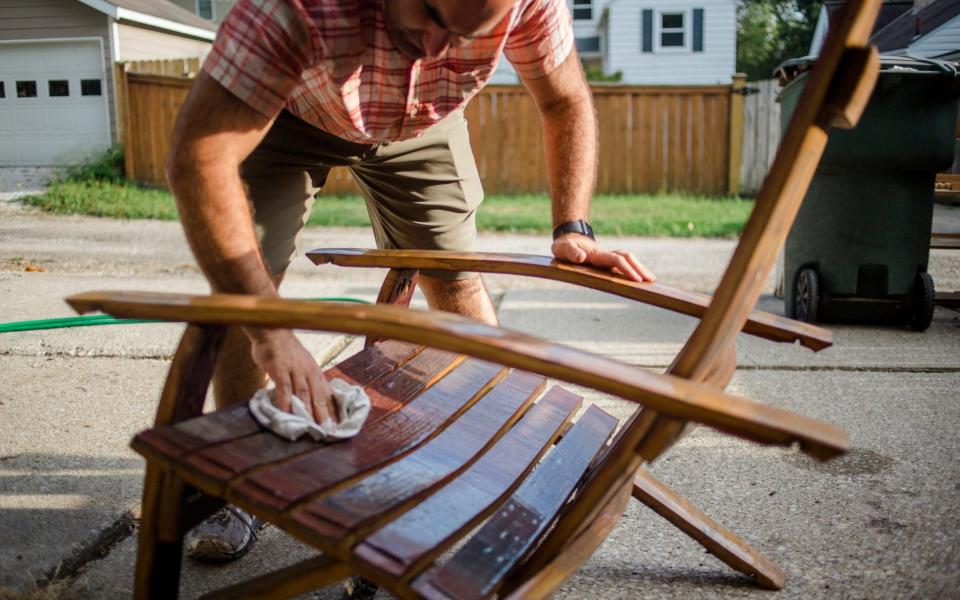
If your furniture is looking past its best, you may not need to replace it. “Painting furniture is an effective way to breathe life into existing pieces,” says Ruth Mottershead, creative director at Little Greene. “With earthy hues, or the timeless combination of blue and white, even a simple weekend project can transform your garden for the summer months.”
“To prepare wood, scrub with sugar soap or mild detergent,” advises Aaron Markwell, colour consultant at Coat Paints. “If there is stubborn mould or mildew, mix 250ml of household bleach with 250ml of washing powder in 750ml of warm water. Use the solution to clean the furniture and leave for five minutes before rinsing, then allow to dry thoroughly. Sanding wood before painting is hard work but will remove surface imperfections while creating a ‘key’ for the paint to adhere to.”
“Priming isn’t always necessary,” says Markwell, “but if the wood has knots, you’re painting over dark with light or if you haven’t completely removed all of the previous treatment, it will prevent the topcoat looking patchy.” Use a paint recommended for outdoor use such as exterior eggshell, and work when the weather is warm and mild. If it’s too hot or sunny, it can negatively affect the way the paint dries.
“Be aware that garden furniture is most often used on bright, clear days, but sunlight can make things look washed out,” says Ken Jensen, senior technical consultant at Sadolin. “It’s a good idea to use colours that are one or two shades darker than you would indoors. If you want to see original wood markings through the colour, choose a transparent or semi-transparent stain. The final colour will greatly depend on the original wood so test on an inconspicuous area before going ahead with the whole project.”
Metal and even plastic furniture can also be given an uplift with a fresh coat of paint. Ensure the surface is clean, either by jet-washing or rubbing with warm soapy water, then lightly sand, removing any rust, to create an even surface. Apply a coat of all-surface primer and two coats of exterior gloss or exterior eggshell. Leave the paint to cure for 3-5 days before using the furniture.
A good vintage
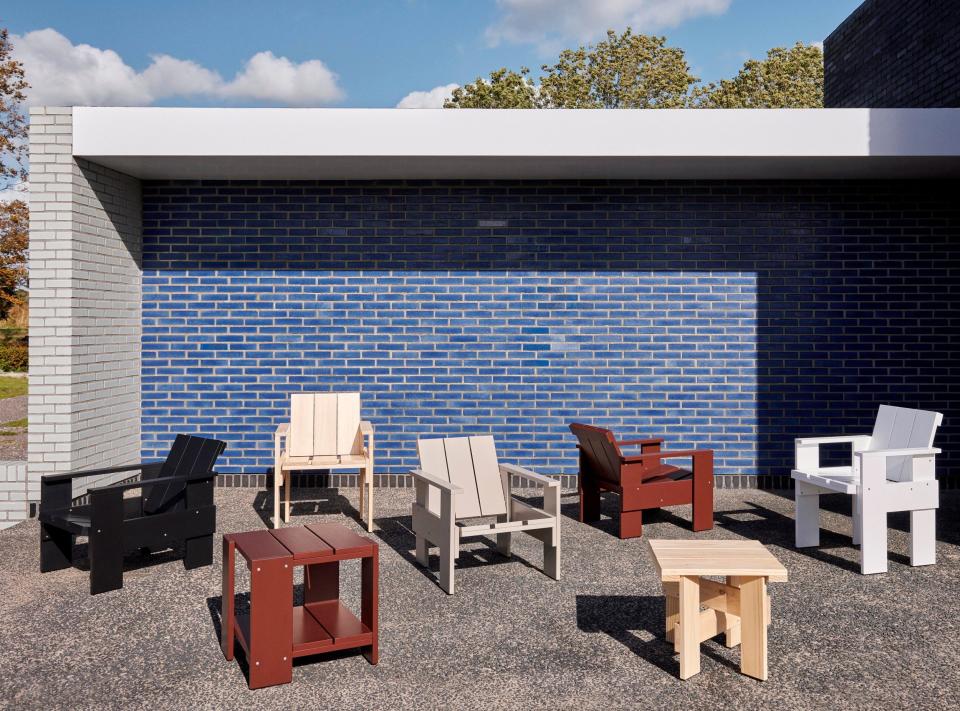
An environmentally sound alternative to buying brand new, vintage garden furniture in good condition will already have stood the test of time.
“Pieces by Tolix will never go out of fashion and can be left outside come rain or shine,” says Paul Middlemiss, owner of Hampshire-based vintage emporium Merchant & Found (merchantandfound.com). “The Tolix model A chair, originally designed in 1934, is potentially the most iconic French café chair of all time.”
Other pieces he recommends scouting for include French Mullca chairs and 1950s Toledo chairs, a stacking design often used in marketing to promote beer, which sometimes comes stamped with brewers’ names.
“You can also buy beautiful folding vintage pieces that work well both outside and in, and can be easily stored during winter,” says Middlemiss. “Beech 1950s German folding dining chairs are a good option, as are German folding tables, which are stable, strong and will last for years.”
Try these...

Wood-effect resin table
A real investment piece, the Tjikko dining table blends design and practicality and is made from hand-painted resin that creates a striking wood effect. £2,895, Oka
Crate low side table
Originally designed in 1934 to use wood from transportation, the Crate collection has been re-issued in FSC certified solid pine coated in water-based lacquer. From £225 for a side table, Hay at SCP
Stackable teak collection
The AH Outdoor Series is a collection of teak pieces that can be mixed and matched and stacked away for ease of storage. From £282 for a table, Carl Hansen & Son
Teak and steel rocking chair
Crafted from teak and powder-coated steel in a range of colours, the Surprising rocking chair provides optimal balance and exceptional comfort. £460, Fermob
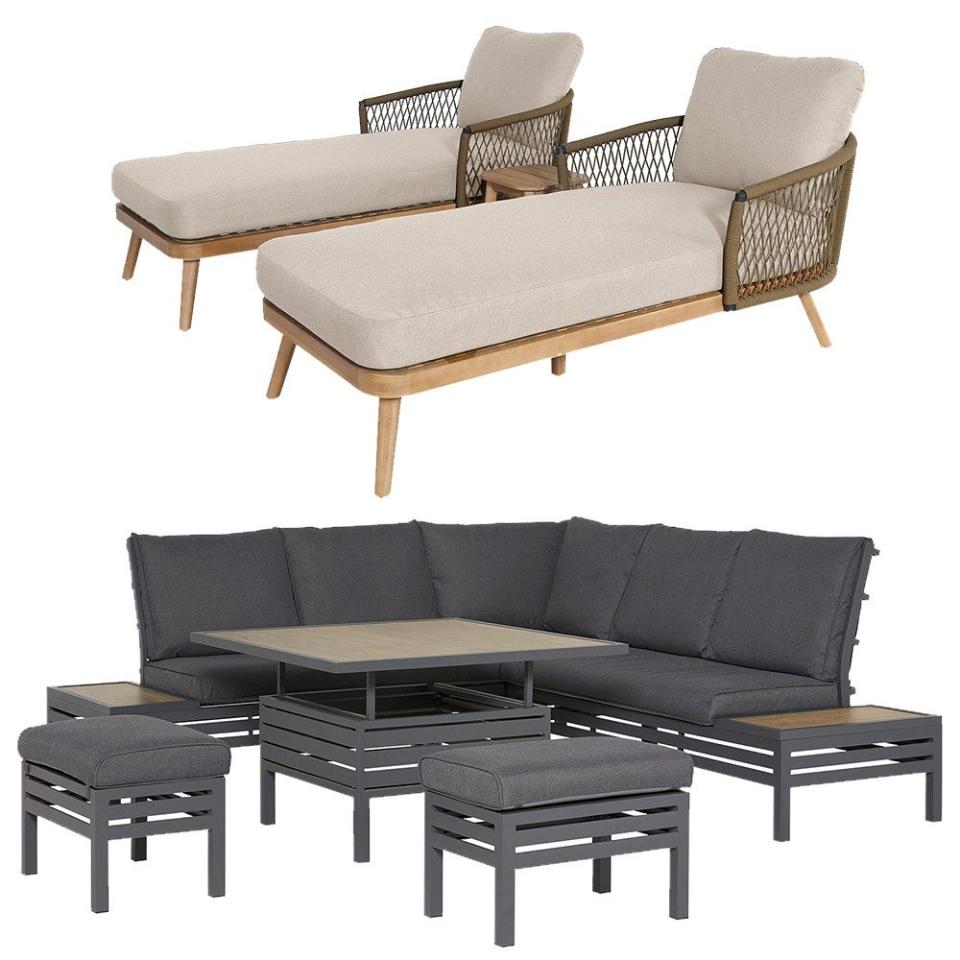
Acacia wood loungers
Bali is a versatile range of loungers, sofa sets and tables in rope weave and acacia wood with water repellant and UV resistant cushions. From £1,099 for a double lounger set, Maze
Sustainable dining set
With an aluminium frame, recycled plastic cushions and a glass top dining table, the Sustainable Modular Dining Set is entirely recyclable. £2,499, Barker and Stonehouse

